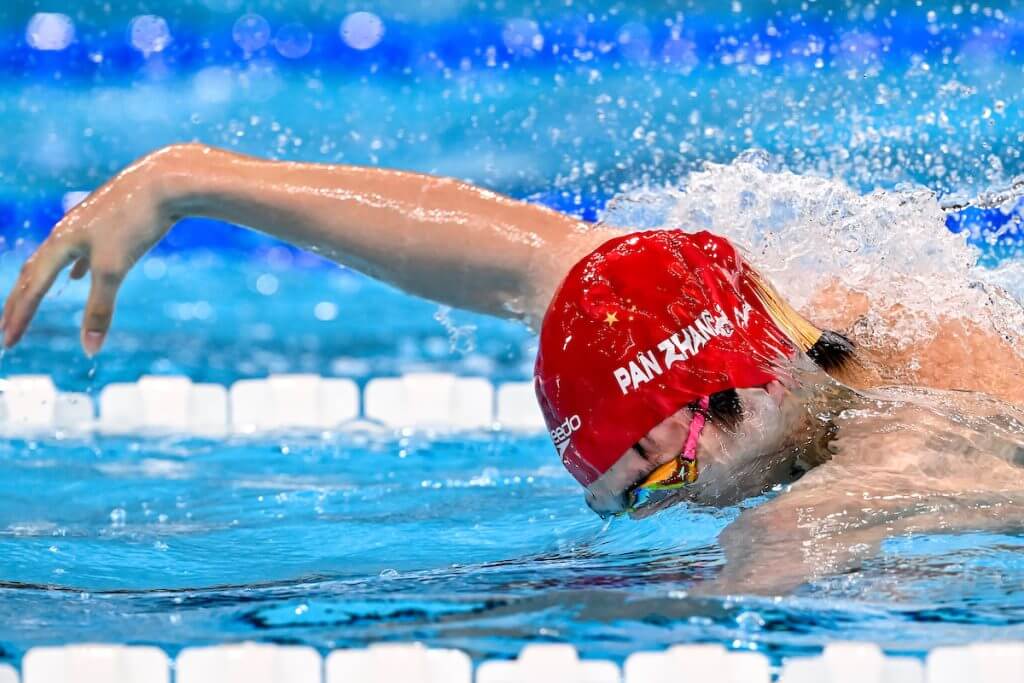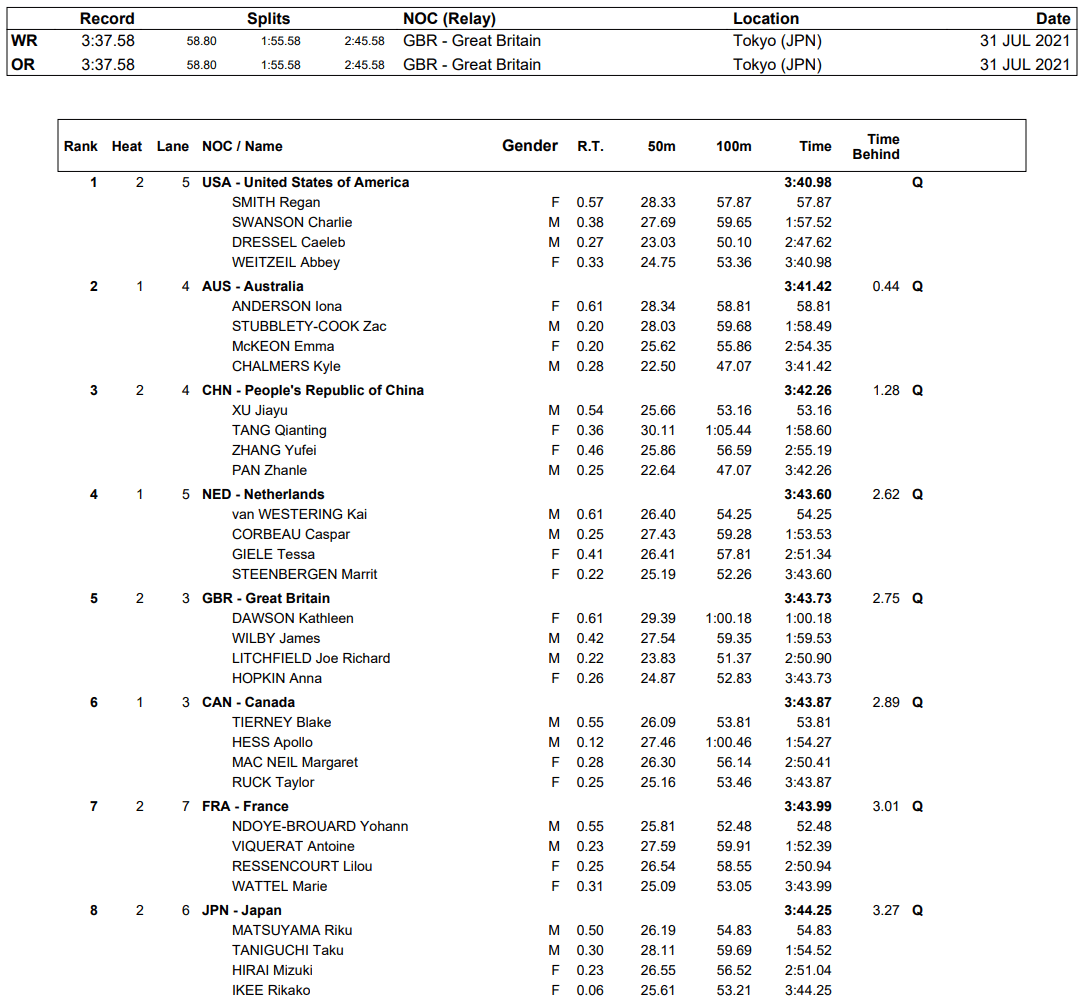Paris Olympics, Day 7 Prelims: United States, Australia, China Set Up Mixed Medley Relay Clash

Paris Olympics, Day 7 Prelims: United States, Australia, China Set Up Mixed Medley Relay Clash
In the first edition of the mixed 400 medley relay at the Olympic Games, the United States learned a valuable lesson about proper roster orders in the event. The Americans chose to swim female swimmers on the middle two legs, a strategy that backfired significantly as Caeleb Dressel was left with far too much ground to make up on the freestyle leg, and the Americans ended up fifth. The team will seek redemption from lane four in the final, but key challengers from Australia and China will race on either side.
The U.S. sent out Regan Smith, Charlie Swanson, Caeleb Dressel and Abbey Weitzeil in the morning. Smith clocked 57.87 on the way out despite swimming through heavy chop as she raced male swimmers, including 100 back silver medalist Xu Jiayu of China, and Swanson (59.65), Dressel (50.10) and Weitzeil (53.36) were all solid in recording the top mark of 3:40.98.
- World Record: Great Britain (Dawson, Peaty, Guy, Hopkin) – 3:37.58 (2021)
- Olympic Record: Great Britain (Dawson, Peaty, Guy, Hopkin) – 3:37.58 (2021)
- Tokyo Olympic Champion: Great Britain (Dawson, Peaty, Guy, Hopkin) – 3:37.58
The Chinese team, meanwhile, utilized the same strategy that doomed the Americans in Tokyo, with female swimmers on the middle legs and men bookending the squad. China won the world title in this event last year with Xu Jiayu, Qin Haiyang, Zhang Yufei and Cheng Yujie, but the struggles of Qin (seventh in the 100 breast) and emergence of Pan Zhanle (100 free gold medalist and world-record holder) and Tang Qianting (100 breast silver medalist) put this alternate strategy into play.
China ended up finishing second to the Americans in the heat even though Pan entered the water in seventh place following Zhang’s 56.59 fly split. He came home in 47.07 while fighting through heavy chop from the teams in front of him. We’ll see if China opts to retain the Xu-Tang-Zhang-Pan lineup in the final or revert to the more conventional strategy, with Qin taking over breaststroke duties and Yang Junxuan to anchor.
Australia went with Iona Anderson, Zac Stubblety-Cook, Emma McKeon and Kyle Chalmers and won the first heat of the event in 3:41.42. The Aussies will also likely bring out a new group Saturday evening, with 100 back Olympic champion Kaylee McKeown sure to lead off and 200 free Olympic champion Mollie O’Callaghan to anchor.
McKeon split 55.86 in prelims, and if Australia wins a medal in the final, McKeon will earn the 13th such honor of her career. Katie Ledecky currently owns the record for most all-time medals by a female swimmer with 13, but she will likely have added to that total with the 800 free final taking place before the mixed relay. McKeon would then have a chance to tie Ledecky in the final race of the meet, when she will handle the butterfly for the Australian’s 400 medley relay team.
The Netherlands, fueled by Caspar Corbeau splitting 59.28 on breaststroke and Marrit Steenbergen coming home in 52.26, took fourth in 3:43.60, and defending Olympic champion Great Britain placed fifth in 3:43.75. The Brits are likely to insert Adam Peaty for the final, provided he is recovered from his COVID-19 diagnosis, but the British women likely to compete here lack the speed to keep up with other top contenders. The fastest possible British squad would include Oliver Morgan, Peaty, Keanna MacInnes and Anna Hopkin.
Canada, with Maggie Mac Neil going 56.14 on fly, took sixth in 3:43.87, followed by France (3:43.99) and Japan (3:44.25). Yohan Ndoye-Brouard swam a best time of 52.48 leading off for French squad, and we’ll see if France turns to Leon Marchand and/or Maxime Grousset in the final. A team of Emma Terebo, Marchand, Grousset and Marie Wattel would have an outside shot at a medal, but a breakdown of composite splits shows the Americans, Chinese and Australian teams significantly clear of the field.
Relay Breakdown For Final
Success in the mixed medley relay on the international level typically requires utilization of a male backstroker and female freestyler because of the differences in time between the two genders in those strokes (breaststroke with the greatest difference, freestyle the least). The choice of males and females for backstroke and butterfly can be interchangeable depending on the specific members of the group.
The United States could go with two different orders here, both of which would include men’s 100 breaststroke silver medalist Nic Fink and women’s 100 freestyle silver medalist Torri Huske in those strokes. Smith on backstroke and Dressel on butterfly was one option, but given the American pattern of bringing in an entirely new team in the final, the more likely scenario would feature men’s 100 backstroke bronze medalist Ryan Murphy and women’s 100 butterfly silver medalist Gretchen Walsh.
Huske defeated Walsh for gold in the 100 fly, but her presence on freestyle (with a 52.29 mark in the final) is too valuable for the U.S. to pass up, particularly with Walsh owning the 100 fly world record at 55.18 and swimming an Olympic-record time of 55.38 in the semifinals. If the U.S. indeed swims two male swimmers and then Huske and Walsh, they would likely be tasked with holding off male counterparts from other countries down the stretch.
China’s two options for order result in about the same composite time, meaning that the team’s coaches would have to make a judgement call. Key is breaststroke: do they trust Qin’s form after he faded significantly in both individual breaststroke events, or would they rather go with Tang, who owns the top time in the world in the 100 breast.
Of the big-three contenders, only Australia has clear-cut strategy for the final, given the excellence of McKeown and O’Callaghan. Matt Temple is sure to handle the butterfly leg, and thanks to the struggles of Sam Williamson and Joshua Yong, Stubblety-Cook will likely retain that second leg after winning 200 breast silver Wednesday evening.
Below is the analysis of relays using composite times recorded thus far in Paris. Since Stubblety-Cook did not swim the individual 100 breast, his split from Friday’s prelims is included here, while the fly times for Dressel and Temple are season-best marks since the individual 100 fly is still in progress.
United States Option 1: Murphy 52.39 + Fink 59.05 + Walsh 55.38 + Huske 52.29 = 3:39.11
United States Option 2: Smith 57.66 + Fink 59.05 + Dressel 50.19 + Huske 52.29 = 3:39.19
China Option 1: Xu 52.02 + Qin 58.93 + Zhang 56.21 + Yang 52.48 = 3:39.64
China Option 2: Xu 52.02 + Tang 1:05.54 + Zhang 56.21 + Pan 46.40 = 3:40.17
Australia: McKeown 57.33 + Stubblety-Cook 59.68 + Temple 50.61 + O’Callaghan 52.24 = 3:19.86
We’ll see exactly what lineups the coaches for the three respective countries will choose for the final, but expect the United States to try building a lead and aiming to hang on while China’s strategy is more of a wildcard. With the female 100 freestylers for all three countries swimming only tenths apart in their best times in Paris, this might come down to who is best equipped to hold on down the stretch.


- EVENT PAGE
- SCHEDULE
- VENUE
- STREAMING INFO
- DAY 1 PRELIMS RESULTS
- DAY 1 FINALS RESULTS
- DAY 2 PRELIMS RESULTS
- DAY 2 FINALS RESULTS
- DAY 3 PRELIMS RESULTS
- DAY 3 FINALS RESULTS
- DAY 4 PRELIMS RESULTS
- DAY 4 FINALS RESULTS
- DAY 5 PRELIMS RESULTS
- DAY 5 FINALS RESULTS
- DAY 6 PRELIMS RESULTS
- DAY 6 FINALS RESULTS
- DAY 7 PRELIMS RESULTS
- DAY 7 FINALS RESULTS
- DAY 8 PRELIMS RESULTS
- DAY 8 FINALS RESULTS
- DAY 9 FINALS RESULTS



